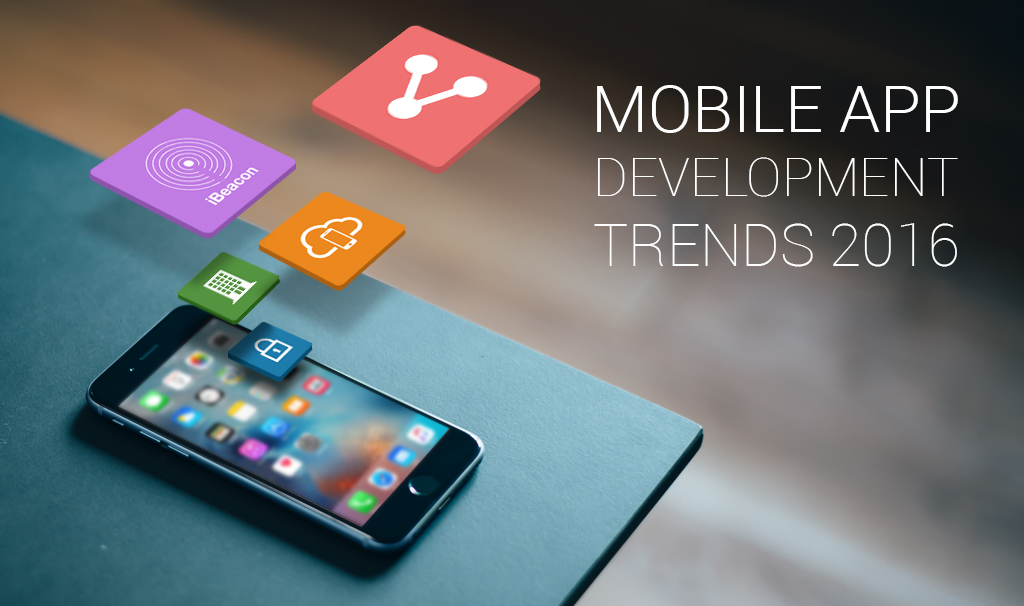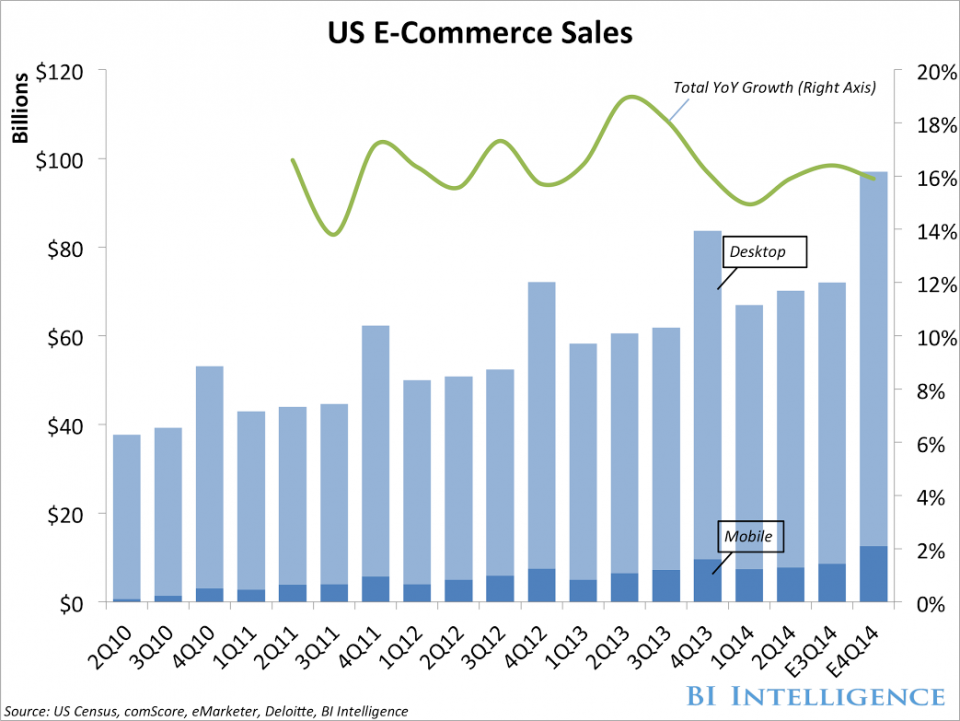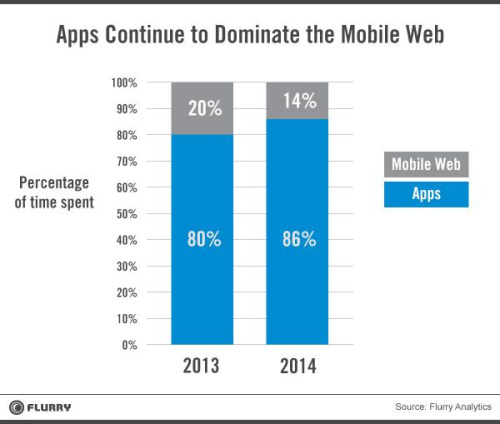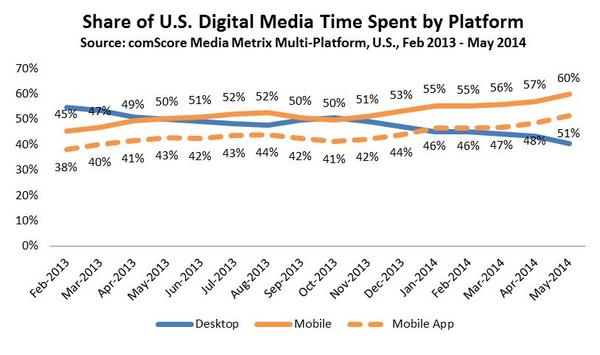Mobile App Development Trends to Look Out in 2016

My predictions for mobile app development landscape in and beyond 2016 – do you think that I am a little early this year? Indeed, I’m not. In the past couple of years, mobile apps industry has witnessed some breakneck innovations. Phenomenal gadgets such as SmartWears, Apple Watch, Google Glass, to technologies such as Cloud Computing, IoT and Big Data has been in the spotlight. This certainly claims that mobile app scenario is undergoing a drastic makeover.
Gartner Analysts get to predict the future of various technologies (mobile, web, software) every year. And this year, they came up with some aspiring mobile app assumptions where they claim, 40% of application leaders will spend more time preparing for mobile app development than they will be delivering actual mobile apps. (Read more about Gartner’s Research in Richard Marshall’s Post)
I think the percentage of people spending more time could be even higher if leaders are slow to adopt a sensible platform-based approach. It is somewhat self-serving to say so, but I also have enough evidence for now to make the platform case self-evident.
Stats that say “App is the next Kingpin”…
- As per BI Intelligence Report, purchases made through mobile devices has increased 48 percent YoY to around $8 billion in the second quarter of 2014. (now that collects a lot of ‘$’ BILLS in app development piggy banks, CHUCKLE!)

- Again if I look into the data shared by Flurry Analytics, the average US mobile users spend 86% of the Smartphone time on apps.

- On May 2014, it was noted down that 60% of the total media time was consumed by mobiles and among them 51 percent was eaten by app surfing, says comScore

All these numbers shared above claims the ubiquitous presence of mobile apps in the coming days. But to enjoy the benefits, keep a tab on the latest trends of mobile app development to survive the cut-throat competition. Here are some predictions that are going to keep developers busy in 2016.
Mobile App Security is in Spotlight
In 2015, Gartner report predicts that more than 75% of apps will fail to meet basic security measures. The prediction came true since the developers were quite busy with security issues throughout the year. The way it is developing, it is likely going to be the prime focus in 2016 and beyond.
iOS 9 has recently considered security as one of the important parameters so the developers have to strive that their apps run smoothly and securely on this platform. Android, on the other hand, is yet not strict, but with the release of Android 6.0 or Marshmallow, they are beefing up the security measures.
If you want your app to reign the stores successfully, you cannot ignore the security glitches. If the platforms do not implement strict security protocols, then the sensitive information of users like SSN or bank details become prone to hacking or leakage. Indeed, this is a major headache for the app developers!
Enterprise Apps Hit it High
More than 60% of the people who control companies and budgets, expect to invest in apps to boost productivity. In both App Store and Play Store, there are more than 1 million apps, but among all, enterprise apps have gained more traction. Consumer applications lie way behind.
Around 20 percent of the developers are now targeting enterprise apps. And 43% of developers who create enterprise apps, makes more than $10K every month compared to developers associated with the development of consumer apps. Obviously that’s profitable and developers will be looking for a makeshift.
Research also shows that global enterprises who use such solution for their employees are going to have a happy workforce and will also witness an increase in the customer satisfaction. Some of the forerunners are financial services, travel agencies, and insurance companies, but some aggressive adopters have joined recently they are online retailers, hotels, airlines.
All Apps Will Now be Cloud Driven
“The convergence of cloud and mobile computing will continue to promote the growth of centrally coordinated applications that can be delivered to any devices.”
I remember a Gartner Contributor, Andrew Spender who at the start of 2015 was right enough to quote that and see in 2015 and beyond cloud technology influenced mobile app sphere a lot. This trend is going to continue in the upcoming years as well.
- Today cloud comes with a number of benefits.
- Developers can use it to retain the small size of the apps.
- Manage bandwidth or different memory issues.
- Cloud compatibility allows people to sync their apps across different smart devices.
Good news for wearable app developers! – The cloud has gained more impetus with the rise of wearable devices. Google Glass though failed to create an impact, but Apple Watch, Samsung Gear have rocked the stage. Apple at present offers more than 10,000 apps to their Smartwatch users. By the end of 2016, the number is going to crawl up to three times. So WatchKit developers are going to have a great time ahead, as app extensions for smartwatches is on the rise.
Beacon Technology Will Gain Traction
Beacon technology has rolled out to merge offline and online differences – be it is a retail sector, event management or finance. The technology has advanced in iOS and expects to invade Android in future. Every industry from Retail, Hospitality, Tourism, Education, Healthcare, Entertainment, Travel, Corporate, Real Estate, Automotive, Advertising all received huge benefits from beacons.
For example, Beacons are often used in large buildings as it helps to provide its internal mapping. So when an emergency occurs, the first responders can quickly rush to the place where the issue has cropped up. You will get a list of last known locations tracked by beacons or temperature sensors to determine dangerous zones in case of emergencies such as a fire break.
Internet of Things (IoT) takes the Center Stage
Internet of Things (IoT) has set a buzz in app development and all credit goes to Google Glass, iWatch, and other wearable devices. It is all set to take app development to a new level. Technavio predicts that IoT will grow by 31.72% (CAGR) between 2014 and 2019.
Talking of IoT, I witnessed that much of the innovation is fueled by young and dynamic startups, better to say the ‘maker generations”. Gartner thus predicted that by 2017, 50 percent of IoT solutions will begin in the startup companies who are less than 3 years old.
The innovation coming around IoT is however mainly focused on the consumer market, but a majority of the technology can find ideal use in sectors like commercial and industrial. Gartner thus assumes that the revenue generated by IoT products and services will exceed $300 billion in 2020.
Even though IoT is in their early stage of development but it has opened the doors for a further development of apps with advanced features. Such as smart cars will be able to connect systems like a traffic signal. The signal’s sensor in turn will give traffic directions, current weather conditions, send accident alerts and provide alternate route options to the driver.
Various enterprises have also started to integrate IoT. It will bring more development, new standards, increased automation, vertical services and their own security and privacy concerns. And in the future we expect to see more private cloud networks and will work over a broad range of sensor-embedded systems, other than wearables and mobiles.
Wrapping Up!
Already a few of these mobile app development trends are steadily gaining momentum and are sure enough to gain attentions of the app developers in 2016. No doubt they are going to make significant marks. It is high time for all of us to brace ourselves and create an ultimate mobile experience for our users. Are you ready to try these trends? Share your thoughts with us.